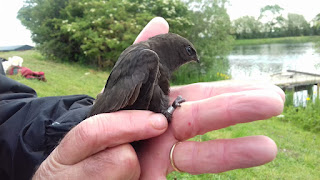Well, during cool and or wet summer days they need to fly low in order to catch their food which are near the surface-especially over lakes.
Even then its not easy because as you can imagine they have excellent eyesight and see normal mist nets very easily. So we adopt a technique called flick netting--see the picture below.
The idea is that you have a net fixed to a vertical pole at one end, then hold the other end on a short pole and let the net rest on the ground. As said Swift flies over he net the operator pulls the net up quickly into the vertical, and bags the bird safely-as seen in the pic.
We managed 23 new birds this morning plus a retrap from 2017--goodness knows how many miles that bird has flown in the intervening period!!
the ring on the well travelled retrap
big eye-small bill--big gape




